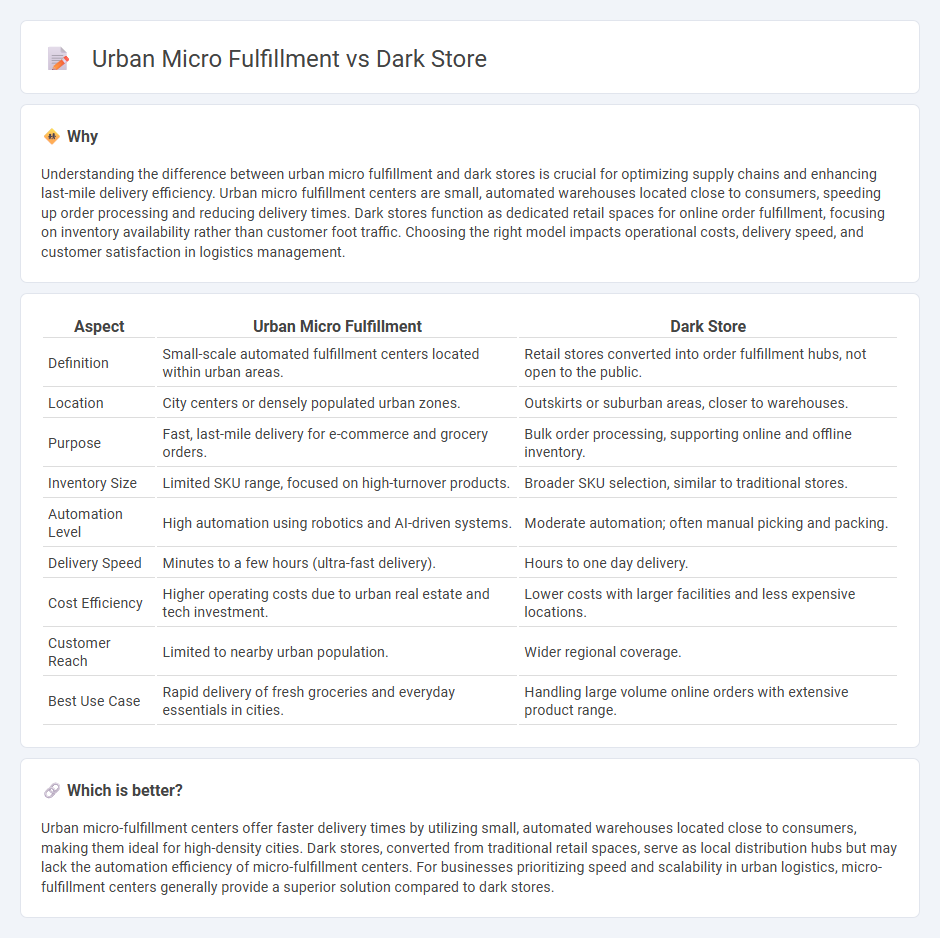
Urban micro-fulfillment centers are compact, automated facilities located within city limits designed to expedite e-commerce order fulfillment and reduce last-mile delivery times. Dark stores function as local distribution hubs, optimized exclusively for online order processing without customer foot traffic, enhancing inventory management and speed. Learn more about how these innovative logistics models transform urban supply chains and boost retail efficiency.
Why it is important
Understanding the difference between urban micro fulfillment and dark stores is crucial for optimizing supply chains and enhancing last-mile delivery efficiency. Urban micro fulfillment centers are small, automated warehouses located close to consumers, speeding up order processing and reducing delivery times. Dark stores function as dedicated retail spaces for online order fulfillment, focusing on inventory availability rather than customer foot traffic. Choosing the right model impacts operational costs, delivery speed, and customer satisfaction in logistics management.
Comparison Table
| Aspect | Urban Micro Fulfillment | Dark Store |
|---|---|---|
| Definition | Small-scale automated fulfillment centers located within urban areas. | Retail stores converted into order fulfillment hubs, not open to the public. |
| Location | City centers or densely populated urban zones. | Outskirts or suburban areas, closer to warehouses. |
| Purpose | Fast, last-mile delivery for e-commerce and grocery orders. | Bulk order processing, supporting online and offline inventory. |
| Inventory Size | Limited SKU range, focused on high-turnover products. | Broader SKU selection, similar to traditional stores. |
| Automation Level | High automation using robotics and AI-driven systems. | Moderate automation; often manual picking and packing. |
| Delivery Speed | Minutes to a few hours (ultra-fast delivery). | Hours to one day delivery. |
| Cost Efficiency | Higher operating costs due to urban real estate and tech investment. | Lower costs with larger facilities and less expensive locations. |
| Customer Reach | Limited to nearby urban population. | Wider regional coverage. |
| Best Use Case | Rapid delivery of fresh groceries and everyday essentials in cities. | Handling large volume online orders with extensive product range. |
Which is better?
Urban micro-fulfillment centers offer faster delivery times by utilizing small, automated warehouses located close to consumers, making them ideal for high-density cities. Dark stores, converted from traditional retail spaces, serve as local distribution hubs but may lack the automation efficiency of micro-fulfillment centers. For businesses prioritizing speed and scalability in urban logistics, micro-fulfillment centers generally provide a superior solution compared to dark stores.
Connection
Urban micro fulfillment centers optimize last-mile logistics by using dark stores strategically located in dense city areas to store and process inventory. These facilities enable rapid order picking and delivery, reducing transportation costs and delivery times for e-commerce businesses. Integration of urban micro fulfillment with dark stores enhances supply chain efficiency and meets consumer demand for speedy urban deliveries.
Key Terms
Location Optimization
Dark stores are strategically located in low-rent areas on city outskirts to minimize operating costs, while urban micro fulfillment centers prioritize proximity to high-density residential neighborhoods for faster last-mile delivery. Both models leverage location optimization to balance cost efficiency and delivery speed, with dark stores serving bulk inventory and micro fulfillment centers focusing on smaller, rapid-turnover stock. Explore further to understand which location strategy best enhances supply chain performance and customer satisfaction.
Order Picking Efficiency
Dark stores operate as dedicated retail warehouses optimized for high-volume order picking, leveraging extensive SKU variety and advanced automation to enhance picking speed and accuracy. Urban micro fulfillment centers are smaller, strategically located facilities designed for rapid order picking and delivery within dense city environments, prioritizing proximity and low latency over large inventory depth. Explore the key differences in order picking efficiency between these models to determine the best fulfillment strategy for your business.
Last-Mile Delivery
Dark stores serve as localized distribution centers designed solely for online order fulfillment, optimizing inventory management and reducing delivery times in dense urban areas. Urban micro fulfillment centers integrate automated systems in compact spaces within cities, enabling faster last-mile delivery by minimizing transit distances and improving order throughput. Explore in-depth insights to understand which solution best enhances your last-mile delivery strategy.
Source and External Links
Dark store - Wikipedia - A dark store is a retail outlet or distribution centre that serves exclusively online shopping, functioning as a warehouse for order fulfillment and click-and-collect services, initially popularized in the UK and now used widely in Europe, Russia, and the US.
What is a Dark Store? How to Make it Work for You - Vaimo - A dark store is a repurposed brick-and-mortar location closed to visitors and dedicated to fulfilling online orders, enabling services like same-day delivery or in-store pickup, and became more widespread during pandemic lockdowns.
What Is a Dark Store? - NetSuite - Dark stores are traditional stores remodeled to operate as mini fulfillment centers for online orders, enhancing delivery and pickup options while leveraging automation and data analytics to manage logistics.
 dowidth.com
dowidth.com